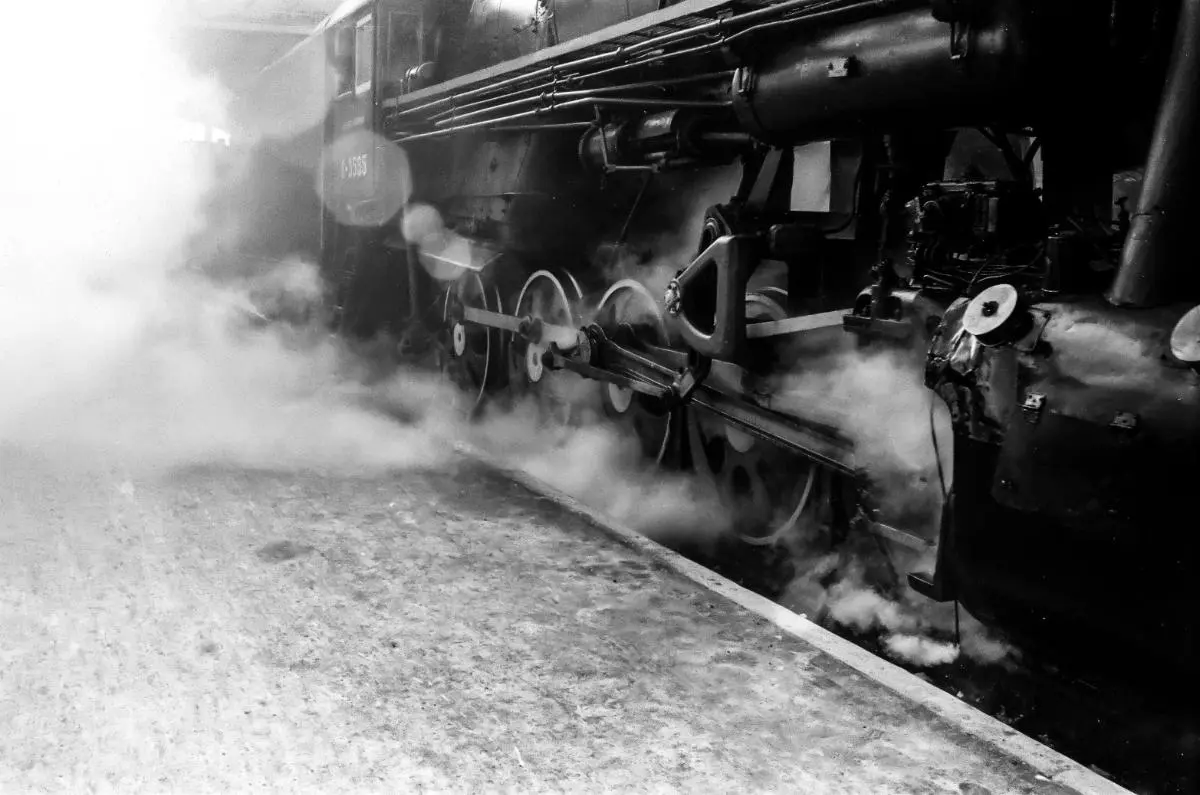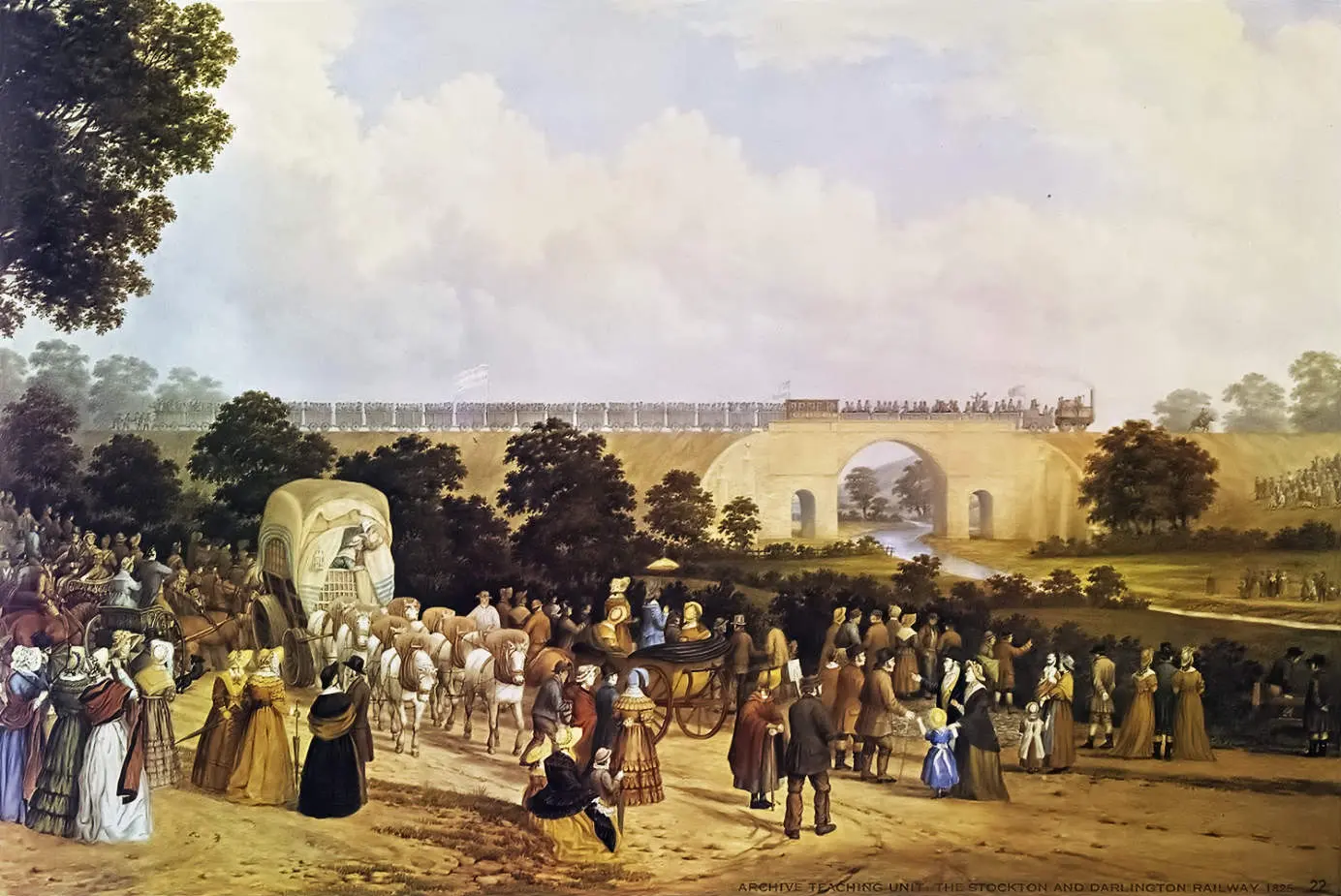The First Transcontinental Railroad: A Historic Achievement
The First Transcontinental Railroad was a monumental feat in United States history. Learn about the history and impact of this groundbreaking achievement.
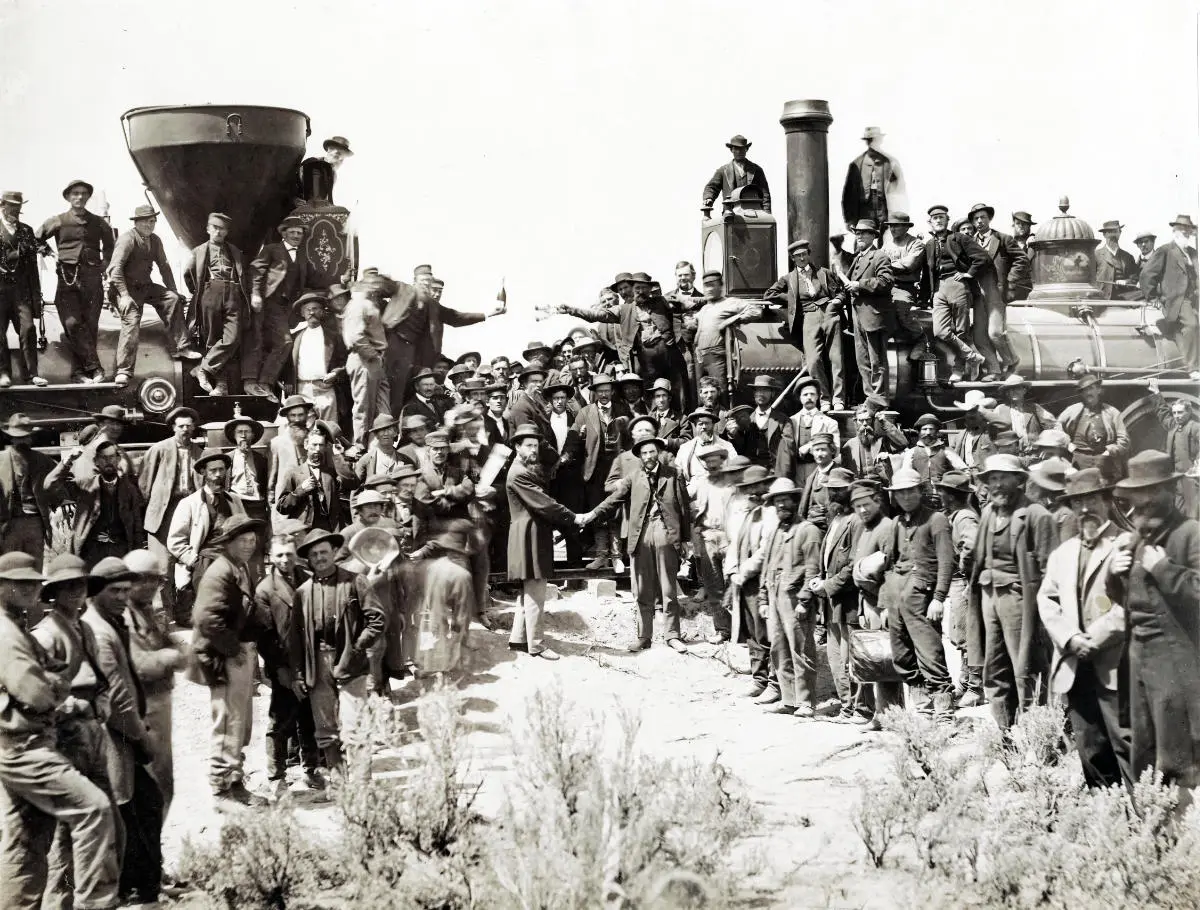
The First transcontinental railroad was a monumental achievement in American history. Connecting the east and west coasts of the United States for the first time, this massive engineering project changed the course of the nation's development and had a lasting impact on the country.
In this blog post, we will explore the history of the First transcontinental railroad, from its inception to its completion, and discuss its significance in shaping the United States as we know it today.
What was the First transcontinental railroad?
The First transcontinental railroad represented a groundbreaking engineering feat, connecting the Atlantic and Pacific coasts via a continuous rail link. Completed over a six-year period, from 1863 to 1869, it effectively bridged the vast expanse between the eastern and western United States.
Spearheaded by two main entities, the Central Pacific Railroad and the Union Pacific Railroad, this endeavor united the country in unprecedented ways. Its construction involved the laborious task of laying thousands of miles of track across challenging landscapes, including desolate deserts, formidable mountains, and wide rivers.
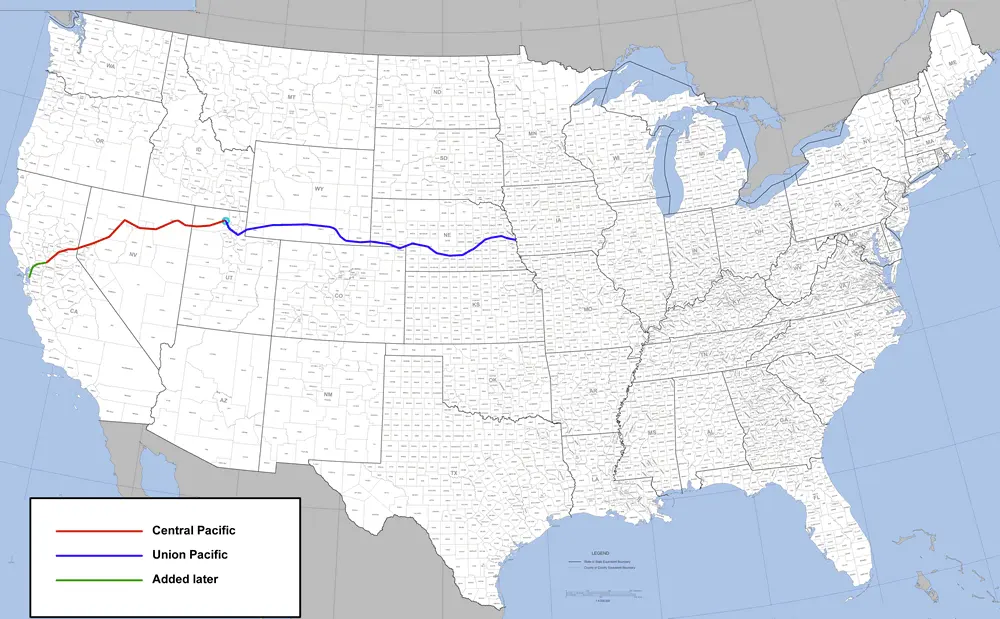
The existence of the railroad marked a pivotal moment in American expansion, facilitating the movement of goods and people with a speed and efficiency previously unimaginable. It not only catalyzed the economic development of the western frontier but also symbolized the technological and entrepreneurial spirit of the age.
The railroad's completion was commemorated by the driving of a golden spike at Promontory Summit, Utah, a symbolic act that represented the culmination of years of toil and ambition. This monumental project not only realized the dream of a nation connected from coast to coast but also set the stage for the United States' emergence as a continental power, weaving together a tapestry of diverse landscapes and communities into a unified whole.
The Dream of a Nation United by Rail
Long before the first iron rail was laid, the vision of a transcontinental railroad captivated the imagination of pioneers and visionaries. Individuals like Asa Whitney and Theodore Judah were not merely dreaming of an engineering marvel; they envisaged a united America, where the Atlantic and Pacific were no longer insurmountable barriers to commerce, communication, and unity.
These early proponents understood the potential of a railroad to knit together a country that was rapidly expanding yet remained fragmented by its vast geography. Their dream was rooted in the belief that such a project could catalyze economic prosperity by opening up new markets and facilitating the efficient movement of goods and people. More than that, they saw the railroad as a bond of steel that could weave together the diverse tapestries of American culture and industry, creating a sense of national identity and shared destiny.
This dream of a nation united by rail spurred the efforts that eventually led to the monumental undertaking of constructing the first transcontinental railroad. It was a dream that would require not just the ingenuity and persistence of thousands of workers but also a commitment from the government and private investors to turn this ambitious vision into a reality.
Amidst political, financial, and technical challenges, the dream of a transcontinental railroad persevered, driven by the unwavering belief in its power to transform the United States.
Legislative Groundwork and the Pacific Railroad Act
The journey to the construction of the First transcontinental railroad took a significant legislative step forward in 1862 with the passing of the Pacific Railroad Act by the United States Congress. This pivotal piece of legislation laid the foundational framework for the monumental task ahead. It granted substantial government backing to the endeavor, providing crucial land grants alongside generous loans.
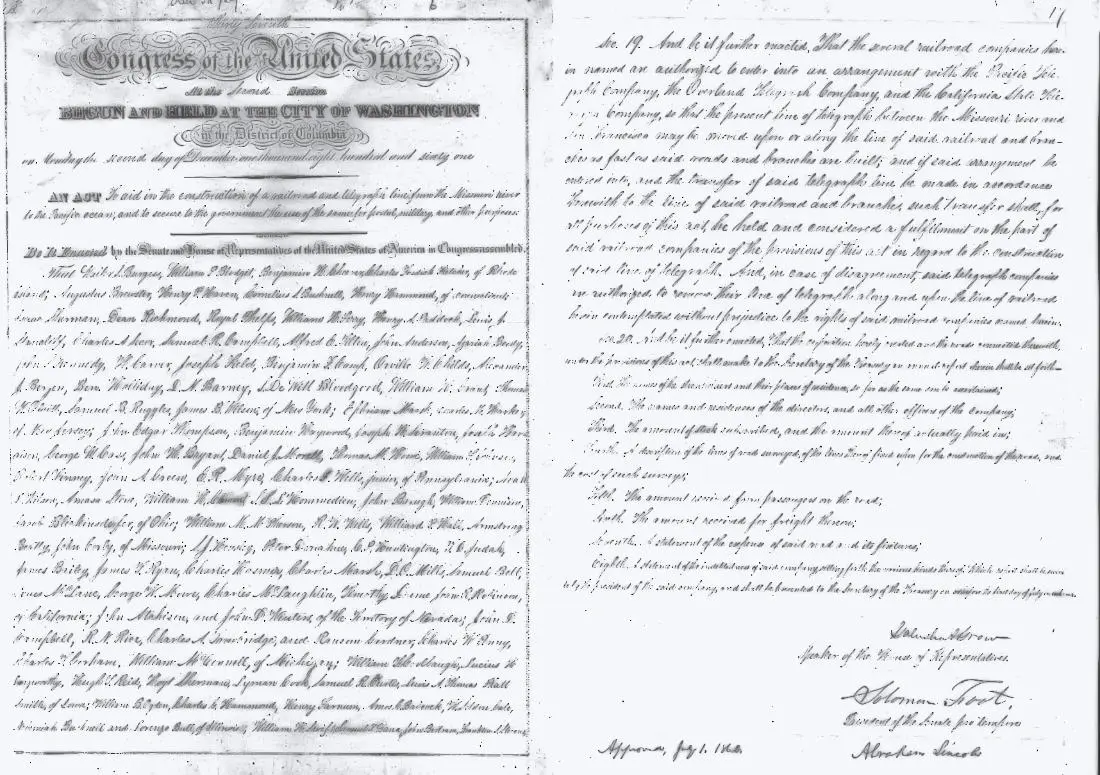
These incentives were aimed at two primary companies: the Central Pacific Railroad, starting its work in California, and the Union Pacific Railroad, beginning in Nebraska. This act represented a vital governmental endorsement of the project, acknowledging the strategic importance of a transcontinental railroad for the nation's future.
By facilitating the allocation of resources and offering financial support, the Pacific Railroad Act served as a catalyst, accelerating the progress of this ambitious project. It underscored the federal government's commitment to bridging the continental divide, thereby transforming the dream of a coast-to-coast railroad into an achievable goal. The act’s passage also highlighted the era's spirit of progress and innovation, showcasing a willingness to invest in infrastructure projects that promised to unite and strengthen the country.
The legislative groundwork laid by the Pacific Railroad Act was instrumental in propelling the United States towards a new era of connectivity and prosperity, marking the beginning of an epic endeavor that would forever change the landscape of the nation.
The Key Players: Central Pacific and Union Pacific
The monumental task of constructing the First transcontinental railroad rested on the shoulders of two railroad giants: the Central Pacific Railroad, which began its journey westward from California, and the Union Pacific Railroad, which laid tracks eastward from Nebraska. These entities were not just business ventures; they were colossal engines of progress, driven by a mix of visionary leadership, daring engineering, and an unwavering commitment to the dream of a nation united by rail.
Under the guidance of influential figures such as Leland Stanford and Collis P. Huntington for the Central Pacific, and Thomas C. Durant and Grenville M. Dodge for the Union Pacific, these companies navigated the immense logistical and engineering challenges that lay in their paths. Their efforts were powered by a diverse workforce, drawing on the strength and skills of thousands, including many immigrants who played crucial roles in the project's success.
The competition between the Central Pacific and Union Pacific was fierce, each pushing the boundaries of railway engineering to secure as much track as possible. This rivalry, while intense, accelerated the pace of construction, propelling both companies towards their historic meeting point at the Promontory Summit. Despite their differences, both railroads shared a common goal: to forge an iron link that would bind the continent, facilitating not just commerce and communication, but also symbolizing the unity and collective ambition of the American people. Their combined efforts epitomized the pioneering spirit of the era, driving the nation into a new chapter of expansion and unity.
Overcoming Natural Barriers
The construction of the First transcontinental railroad presented an array of formidable natural barriers that tested the resolve and ingenuity of its workforce.
Crews contended with the relentless Sierra Nevada and the Rocky Mountains, where steep gradients and treacherous passes necessitated innovative engineering solutions. In these regions, tunnels were carved through solid rock, a laborious process requiring precision and persistence. Dynamite, a relatively new invention at the time, became a crucial tool for blasting through mountainous terrain, but its use was fraught with danger, leading to numerous casualties among the workers.
In addition to the mountains, the expansive deserts of the Great Basin posed their own set of challenges. Here, the scarcity of water and the extreme temperature fluctuations took a toll on the workers, testing their endurance. Supply lines had to be meticulously planned to ensure the continuous flow of materials and provisions to these remote locations.
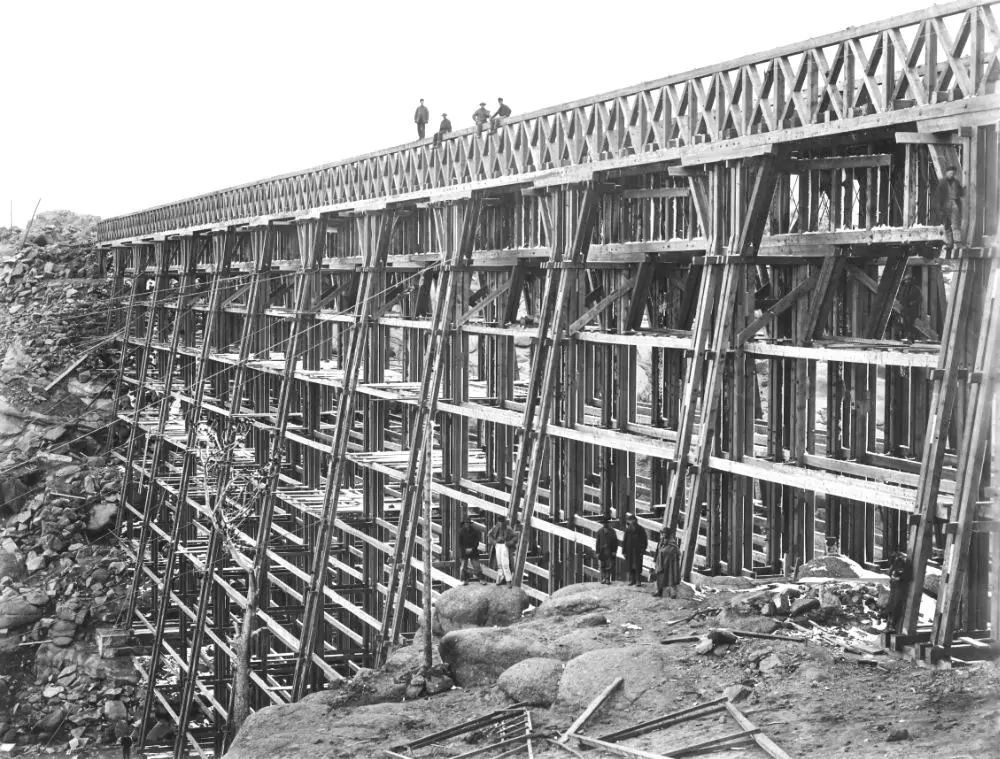
Crossing the wide and often unpredictable rivers along the route added another layer of complexity. Building stable bridges that could withstand the forces of nature required careful planning and construction, often under conditions of great risk to the laborers involved.
Despite these obstacles, the diverse and determined workforce, which included a significant number of Chinese and Irish immigrants, along with Civil War veterans, demonstrated remarkable tenacity. Through their collective efforts, they overcame the natural barriers that lay in their path, advancing the rail line mile by mile towards its historic completion. Their success in this endeavor is a tribute to human perseverance and the transformative power of collective labor toward achieving a common goal.
The Workforce: A Melting Pot of Cultures
The assembly of the First transcontinental railroad was carried out by a mosaic of cultures, each bringing its own unique strengths and experiences to the monumental task at hand.
The Central Pacific relied heavily on the diligence and expertise of Chinese immigrants, who became instrumental in navigating the formidable Sierra Nevada. Their contributions were invaluable, particularly in the most challenging phases of construction, where their skills in explosive handling and tunneling were put to the test, often in very dangerous working conditions that took several lives. On the other side, the Union Pacific's tracks were laid in part by Irish immigrants and recently discharged Civil War veterans, whose resilience and hardiness were crucial in pushing the railway through the Great Plains and over the Rocky Mountains.
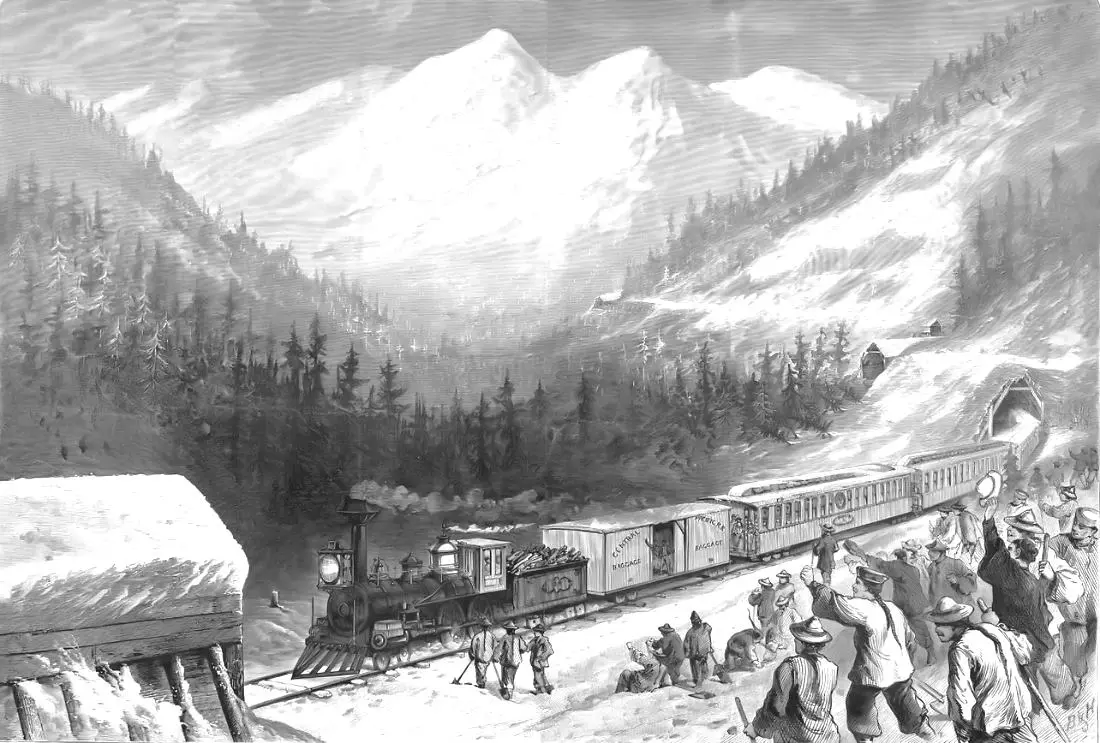
This workforce was not just a labor pool; it was a convergence of different worlds, each with its own language, customs, and traditions. Despite the diversity, or perhaps because of it, these workers forged a sense of camaraderie and shared purpose that propelled the project forward. They faced adversities not just from the rugged landscape but also from the prejudices and tensions that such a melting pot of cultures inevitably brewed.
The intermingling of these various cultures along the railway line did more than just build a railroad; it wove a rich, multicultural tapestry that reflected the broader American ethos. This convergence of diverse backgrounds and skills not only shaped the success of the First transcontinental railroad but also laid down the early tracks of America’s cultural and societal evolution.
The Golden Spike: Completion at Promontory Summit
The crowning moment of the First transcontinental railroad's construction occurred at Promontory Summit, Utah, on a bright May 10, 1869, amid fanfare and anticipation. This historical event was marked by the driving of a ceremonial golden spike into a polished laurel wood tie, symbolizing the uniting of the nation from coast to coast. The atmosphere was electric, as a telegraph wire attached to the spike broadcast the sound of its hammering to eager listeners across the country, effectively shrinking the vast American landscape into a connected continent at the tap of a hammer.
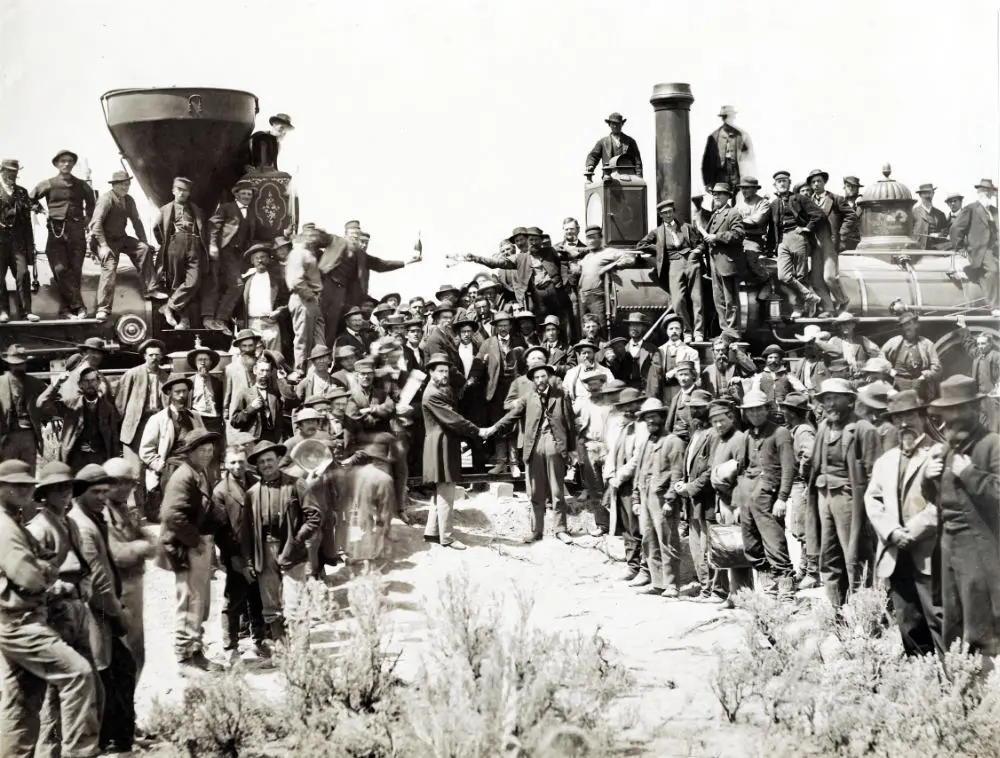
Dignitaries from both the Central Pacific and Union Pacific Railroads, alongside workers, spectators, and the press, gathered to witness this monumental achievement. The golden spike, a gift from David Hewes of San Francisco, bore the inscription, "May God continue the unity of our Country, as this Railroad unites the two great Oceans of the world." This phrase encapsulated the broader significance of the moment - not just the completion of a railroad but the bridging of disparate parts of a rapidly growing nation.
As the final spike was driven, cheers erupted, and the air filled with the sound of band music and the hiss of steam from locomotives. The ceremony at Promontory Summit was not merely the conclusion of an unparalleled engineering endeavor; it was a celebration of human tenacity and the embodiment of a dream that had captivated the nation for decades. This pivotal moment in American history signaled the dawn of a new era of expansion, innovation, and connection, forever altering the landscape and destiny of the United States.
Economic and Social Impact on America
The unveiling of the First transcontinental railroad ushered in an era of unprecedented economic dynamism and social transformation across the United States. By facilitating the swift movement of commodities, it drastically lowered transportation costs, making goods more accessible and affordable for Americans from coast to coast. This connectivity fostered a burgeoning economy, stimulating industries such as agriculture, mining, and manufacturing. Farmers in the Midwest could now ship their produce to markets in the East and West, while resources like coal and precious metals from the Western mines could reach far-off manufacturing hubs.
Moreover, the railroad significantly contributed to the country's demographic shift. It encouraged mass migration to the West, as settlers were drawn by the promise of land and opportunity. This movement populated remote areas, leading to the establishment of new towns and cities along the railroad's path, which in turn became focal points for commerce and community life. The social fabric of America was woven with new patterns, as diverse cultures and communities sprang up, contributing to the rich mosaic of the American identity.
The railroad also revolutionized the postal service and communication, shrinking the time it took for mail and news to traverse the continent. This enhancement in communication fostered a sense of national unity and shared purpose, bridging the physical and metaphorical distances between Americans.
In essence, the economic and social ramifications of the First transcontinental railroad were profound, setting in motion forces that would shape the contours of American society and its economy for generations to come.
The Legacy of the First Transcontinental Railroad
The enduring legacy of the First transcontinental railroad stretches far beyond the iron tracks that connected the Atlantic to the Pacific. It stands as a monumental testament to human ambition and the spirit of innovation that defined an era. This colossal undertaking revolutionized transportation, making the once insurmountable distances across the United States navigable in mere days. Its construction underscored the importance of unity and connectivity, weaving together a nation that was on the cusp of great change.
The railroad catalyzed the economic expansion of the West, attracting a surge of settlers and investors drawn by the promise of prosperity. It facilitated the establishment of new communities and the expansion of existing ones, laying the groundwork for the diverse and dynamic landscape of the American West as known today. Moreover, the First transcontinental railroad played a pivotal role in the industrialization of the nation, providing a reliable supply chain that supported burgeoning industries from coast to coast.
Culturally, it bridged disparate regions, fostering a sense of national identity and shared destiny among the American populace. The exchange of goods, ideas, and cultures that it facilitated enriched the American experience, contributing to a tapestry of diversity and innovation.
Today, the First transcontinental railroad is remembered not just for the physical connection it established, but for the indelible mark it left on the development of the United States, embodying the daring and determination of a nation poised for progress.
Conclusion
The construction of the First transcontinental railroad represents a landmark moment in American history, symbolizing not just an engineering marvel but a unifying force that bridged the vast expanses of the nation.
Its completion marked the beginning of a new era, transforming the landscape of the United States economically, socially, and culturally. The impact of this monumental project went beyond the steel rails that connected the Atlantic and Pacific coasts; it forged a path for future generations, catalyzing growth and innovation across diverse sectors.
By facilitating unprecedented mobility and exchange, it played a crucial role in shaping the nation's destiny. The legacy of the First transcontinental railroad, therefore, lies in its contribution to the development of the United States as a continental power, embodying the spirit of progress and perseverance that continues to inspire.
This epic undertaking not only commemorated the technological achievements of its time but also the collective ambition of a nation striving towards unity and prosperity.

